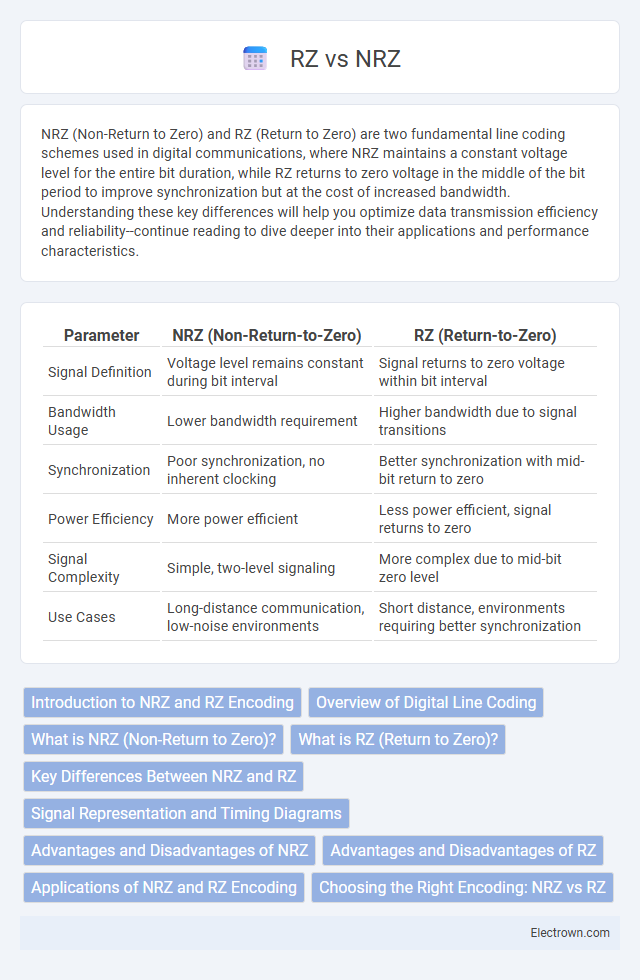NRZ (Non-Return to Zero) and RZ (Return to Zero) are two fundamental line coding schemes used in digital communications, where NRZ maintains a constant voltage level for the entire bit duration, while RZ returns to zero voltage in the middle of the bit period to improve synchronization but at the cost of increased bandwidth. Understanding these key differences will help you optimize data transmission efficiency and reliability--continue reading to dive deeper into their applications and performance characteristics.
Table of Comparison
| Parameter | NRZ (Non-Return-to-Zero) | RZ (Return-to-Zero) |
|---|---|---|
| Signal Definition | Voltage level remains constant during bit interval | Signal returns to zero voltage within bit interval |
| Bandwidth Usage | Lower bandwidth requirement | Higher bandwidth due to signal transitions |
| Synchronization | Poor synchronization, no inherent clocking | Better synchronization with mid-bit return to zero |
| Power Efficiency | More power efficient | Less power efficient, signal returns to zero |
| Signal Complexity | Simple, two-level signaling | More complex due to mid-bit zero level |
| Use Cases | Long-distance communication, low-noise environments | Short distance, environments requiring better synchronization |
Introduction to NRZ and RZ Encoding
NRZ (Non-Return-to-Zero) encoding represents binary data with two distinct voltage levels, maintaining a constant signal level throughout each bit period to maximize bandwidth efficiency. RZ (Return-to-Zero) encoding differs by returning the signal to zero voltage during the middle of each bit period, enhancing synchronization at the cost of doubled bandwidth requirements. Both encoding methods are fundamental in digital communication systems, with NRZ favored for simplicity and RZ for improved timing extraction.
Overview of Digital Line Coding
Non-Return-to-Zero (NRZ) and Return-to-Zero (RZ) are fundamental digital line coding schemes used in data transmission to represent binary signals. NRZ maintains a constant voltage level throughout the bit interval, where a high level represents '1' and a low level represents '0', optimizing bandwidth but suffering from synchronization issues in long sequences without transitions. RZ, by contrast, returns to zero voltage halfway through each bit period, improving synchronization and error detection at the cost of increased bandwidth and reduced power efficiency.
What is NRZ (Non-Return to Zero)?
NRZ (Non-Return to Zero) is a binary signal encoding method where the signal level remains constant during the bit interval, representing binary '1' as a high voltage and binary '0' as a low voltage without returning to zero between bits. This encoding technique optimizes bandwidth efficiency by avoiding unnecessary voltage transitions, making it suitable for high-speed digital communication systems. Understanding NRZ helps you select appropriate signaling schemes for reliable and efficient data transmission.
What is RZ (Return to Zero)?
Return to Zero (RZ) is a line coding scheme where the signal returns to zero voltage level between each bit, enhancing synchronization by providing clear timing boundaries. Unlike Non-Return to Zero (NRZ), RZ uses three voltage levels--positive, zero, and negative--allowing easier distinction between bits but requiring higher bandwidth. This method reduces intersymbol interference and improves error detection in digital communication systems.
Key Differences Between NRZ and RZ
NRZ (Non-Return-to-Zero) and RZ (Return-to-Zero) differ primarily in signal structure and bandwidth requirements. NRZ maintains a constant voltage level throughout the bit duration, offering better bandwidth efficiency but is more susceptible to synchronization issues. RZ signals return to zero voltage within each bit period, improving synchronization and error detection at the cost of higher bandwidth usage, which impacts Your choice based on communication system needs.
Signal Representation and Timing Diagrams
NRZ (Non-Return-to-Zero) signal representation maintains a constant voltage level for the entire bit duration, where a high or low voltage corresponds directly to binary 1 or 0 without returning to zero between bits. RZ (Return-to-Zero) signal representation returns to zero voltage halfway through each bit interval, providing a distinct transition that aids synchronization but reduces bandwidth efficiency. Timing diagrams of NRZ show continuous high or low levels over bit periods, while RZ timing diagrams display pulses returning to zero state, clearly indicating bit boundaries and improving error detection.
Advantages and Disadvantages of NRZ
Non-Return-to-Zero (NRZ) encoding offers high bandwidth efficiency and simplicity by representing binary data with two voltage levels without returning to zero between bits. Its advantages include easier implementation and better performance in terms of bandwidth usage compared to Return-to-Zero (RZ), but NRZ suffers from baseline wander and difficulty in clock recovery due to lack of synchronization pulses. These drawbacks can lead to increased error rates in long-distance communication, making NRZ less suitable for high-speed data transmission where signal integrity is critical.
Advantages and Disadvantages of RZ
Return-to-Zero (RZ) signaling offers advantages such as improved synchronization and reduced baseline wander, making it easier for receivers to maintain timing alignment. However, RZ requires a higher bandwidth than Non-Return-to-Zero (NRZ) due to its frequent transitions, which can lead to increased power consumption and lower spectral efficiency. The signal's periodic return to zero allows for error detection but reduces transmission distance and tolerance to noise compared to NRZ formats.
Applications of NRZ and RZ Encoding
NRZ encoding is widely used in digital communication systems such as Ethernet and USB due to its simplicity and efficient bandwidth utilization. RZ encoding finds applications in optical communication systems and long-distance fiber optic transmission, where signal synchronization and error detection are critical. Both encoding schemes serve key roles in balancing data integrity and transmission efficiency across various networking technologies.
Choosing the Right Encoding: NRZ vs RZ
Choosing the right encoding between NRZ (Non-Return to Zero) and RZ (Return to Zero) depends largely on the specific requirements of bandwidth efficiency and signal synchronization. NRZ encoding offers higher bandwidth efficiency by maintaining a constant signal level for the duration of the bit interval, making it ideal for long-distance and high-speed data transmission. RZ encoding provides better synchronization and error detection capabilities due to its mid-bit return to zero, which helps reduce signal interference and ensures clearer timing, especially in noisy communication channels.
NRZ vs RZ Infographic

 electrown.com
electrown.com